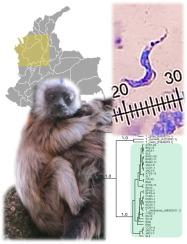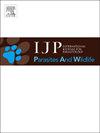Redefining infections with trypanosomatids in Neotropical primates: Case study of the white-footed tamarin (Oedipomidas leucopus)
IF 2
3区 医学
Q3 ECOLOGY
International Journal for Parasitology-Parasites and Wildlife
Pub Date : 2024-11-14
DOI:10.1016/j.ijppaw.2024.101021
引用次数: 0
Abstract
Trypanosomes are blood parasites capable of infecting nearly any vertebrate. Many Neotropical primates frequently host trypanosomes and are considered potential reservoirs for Trypanosoma cruzi and other human-pathogenic trypanosomatids. However, diagnostic methods originally developed for detecting these trypanosomatids in humans and domestic species must be validated to reliably diagnose infections in non-human primates. Without such validation, taxonomic biases and incorrect assignments of wildlife reservoirs can occur. The white-footed tamarin (Oedipomidas leucopus), a primate endemic to northwestern Colombia, is classified by the World Health Organization as a reservoir of T. cruzi. However, this classification is based on studies with small sample sizes, ambiguous diagnostic methods, and questionable geographic records. In this study, the 18S ribosomal RNA gene was amplified via PCR and sequenced to estimate trypanosome infection rates and identify species in natural populations of O. leucopus across a wide geographic range, as well as in (ex situ) specimens. This molecular approach was also compared with traditional microscopy diagnosis using blood smears. The molecular diagnosis revealed that over 60% of the tested specimens were infected, whereas traditional microscopy resulted in 58% false negatives compared to the molecular method. A Bayesian phylogeny of the 18S gene identified T. minasense as the sole trypanosomatid species present in O. leucopus, with no detections of T. cruzi or other trypanosomatids of concern to human or domestic animal health. This study highlights the risk of overestimating the presence of human-infecting trypanosomes, such as T. cruzi, in tamarins and other vertebrates, and underscores the importance of validating diagnostic methods to accurately assess the zoonotic potential of wild species. Accurate identification of wildlife reservoirs is essential for understanding parasite life cycles and implementing effective management and conservation strategies for primates and other potential reservoirs.

重新界定新热带灵长类动物锥虫感染:白脚狨(Oedipomidas leucopus)案例研究
锥虫是一种血液寄生虫,几乎可以感染任何脊椎动物。许多新热带灵长类动物经常寄生锥虫,被认为是克鲁斯锥虫和其他人类致病锥虫的潜在贮藏地。然而,最初为检测人类和家养物种中的锥虫而开发的诊断方法必须经过验证,才能可靠地诊断非人灵长类动物的感染情况。如果没有这种验证,就会出现分类学上的偏差和对野生动物病原的错误判断。白脚狨(Oedipomidas leucopus)是哥伦比亚西北部特有的一种灵长类动物,世界卫生组织将其归类为T. cruzi病毒携带者。然而,这一分类是基于样本量小、诊断方法不明确、地理记录有问题的研究。在这项研究中,通过 PCR 扩增 18S 核糖体 RNA 基因并进行测序,以估计锥虫的感染率,并确定 O. leucopus 在广泛地理范围内的自然种群以及(异地)标本中的物种。这种分子方法还与使用血液涂片的传统显微镜诊断方法进行了比较。分子诊断结果显示,超过 60% 的受测标本受到感染,而与分子方法相比,传统显微镜诊断方法的假阴性率高达 58%。通过对 18S 基因进行贝叶斯系统进化,确定小锥虫是出现在 O. leucopus 身上的唯一锥虫物种,而没有检测到 T. cruzi 或其他与人类或家畜健康有关的锥虫。这项研究强调了高估犭胥和其他脊椎动物体内存在人类感染锥虫(如克鲁斯锥虫)的风险,并强调了验证诊断方法以准确评估野生物种人畜共患病可能性的重要性。要了解寄生虫的生命周期,并对灵长类动物和其他潜在的寄生虫库实施有效的管理和保护策略,就必须准确识别野生动物库。
本文章由计算机程序翻译,如有差异,请以英文原文为准。
求助全文
约1分钟内获得全文
求助全文
来源期刊

International Journal for Parasitology-Parasites and Wildlife
Medicine-Infectious Diseases
CiteScore
3.80
自引率
5.60%
发文量
113
审稿时长
45 days
期刊介绍:
The International Journal for Parasitology: Parasites and Wildlife (IJP-PAW) publishes the results of original research on parasites of all wildlife, invertebrate and vertebrate. This includes free-ranging, wild populations, as well as captive wildlife, semi-domesticated species (e.g. reindeer) and farmed populations of recently domesticated or wild-captured species (e.g. cultured fishes). Articles on all aspects of wildlife parasitology are welcomed including taxonomy, biodiversity and distribution, ecology and epidemiology, population biology and host-parasite relationships. The impact of parasites on the health and conservation of wildlife is seen as an important area covered by the journal especially the potential role of environmental factors, for example climate. Also important to the journal is ''one health'' and the nature of interactions between wildlife, people and domestic animals, including disease emergence and zoonoses.
 求助内容:
求助内容: 应助结果提醒方式:
应助结果提醒方式:


